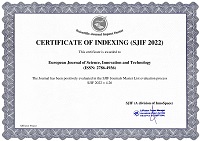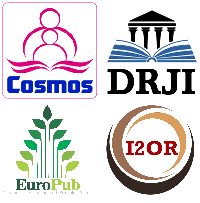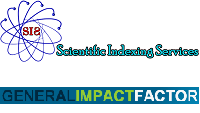Effects of Anthropogenic Activities on Water Quality Parameters of Iju Stream, Ota, Ogun State, Nigeria
Abstract
When solid and liquid wastes enter into water sources unchecked, the water becomes unfit for consumption. When human beings consume such water, they are at risk of waterborne diseases such as dysentery, typhoid and cholera. Therefore, this study investigated the effects that the anthropogenic activities happening around Iju Stream Ota, Ogun State, Nigeria have on the water quality collected from the stream. Three water samples each were collected across the stream (upstream, midstream and downstream) in three different months of 2024 (January, April and August), making a total of nine samples. Samples were collected during both rainy and dry seasons for data to be representative enough. Physico-chemical and microbial parameters were analysed in compliance with American Public Health Association (APHA) (2018) guidelines. Results obtained were compared with World Health Organization (WHO) (2022) standards for drinking water quality. Physico-chemical and microbial results obtained for upstream, midstream and downstream sections in January, April and August respectively were; pH (7.4, 7.6, 8.8); Turbidity (6.7, 6.7, 7.9); Electrical conductivity (122, 131, 131), Nitrate (39, 36, 43), Phosphate (24, 27, 46), Calcium (14.8, 18.6, 20.8), Magnesium (22.6, 25.7, 24), Chloride (10, 13.8, 14.2), Temperature (28 0C, 29 0C, 31 0C), Total dissolved solids (61, 68, 65.9), Dissolved oxygen (8.1, 9.2, 9.9), Hardness (37.4, 39.5, 44.6), Colour (2.80, 3., 3.25), Salinity (7.81, 8.2, 9.04), Manganese (0.01, 0.10, 0.09), Zinc (0.14, 0.14, 0.21), Copper (0.13, 0.19, 0.21), Iron (0.05, 0.09, 0.16), Biochemical oxygen demand (1.09, 1.14, 1.38) and Coliform count (130, 133, 151 cfu) in mg/l. Analysed water samples substantially failed to meet the minimum WHO requirements for drinking water quality. This work is applicable in the protection of surface water for public use and consumption, to preserve public health and prevent waterborne diseases.
References
APEC Water (2016). Importance of water and human health. Asia Pacific Economic Cooperation Guidelines for Quality of Water Infrastructure, 2, 32–41.
APHA (2018). Standard methods for the examination of water and waste water (20th ed., pp. 23–31). Washington, D.C., American Public and Health Association.
Bangalore, S. S., & Latha, S. (2018). Assessment of water quality index for the groundwater of an industrial area in Bangalore, India. Environmental Engineering Science, 25(6), 911-915.
Boateng, T. K., Opokul, F., Acquaah, S. O., & Akoto, O. (2016). Groundwater quality assessment using statistical approach and water quality index in Ejisu-Juaben municipality, Ghana. Environmental Earth Science, 75, 489–496.
Cosgrove, W. J., & Loucks D. P. (2015). Water management: current and future challenges and research directions. Water Resources, 51(6), 4823-4839.
Chmielewski J., Łuszczki J., Czarny-Działak M., Dutkiewicz E., Król H., Gworek B., & Nowak-Starz G. (2021). Environmental exposition to xenoestrogens (XEs) and related health effects. Journal of Elementology, 26(3), 717-730.
Kanu, I., & Achi, O. K. (2011). Industrial effluents and their impact on water quality of receiving rivers in Nigeria. Journal of Applied Technology in Environmental Sanitation, 1(1), 75-86.
Kłos, L. (2016). The quality of drinking water in Poland: Acta University Lodz. Folia Oeconomica, 2(313), 195-205.
Longe, E. O., Omole, D. O., Adewumi, I. K., & Ogbiye, A. S. (2020). Water resources use, abuse and regulations in Nigeria. Journal of Sustainable Development in Africa, 12(2), 35-44.
Makinde, O. W., Adesiyan, T. A., Olabanji, I. O., Tunbosun, I. A., Ogundele, K. T., Adelowotan, O., & Oluyemi, E. A. (2016). Assessment of heavy metals bio-availability in stream sediments around a gold mining environment in south-western Nigeria. Journal of Environmental Application and Science, 11(2), 139-147.
NAS (2016). Safe drinking water is essential: Why is safe water essential? Available at https://www.nasonline.org.
Ogunba, A. (2011). Nigeria’s new environmental laws: What implications for groundwater protection and sustainability? Wastewater Colloquium, South Africa, 7, 82 – 95.
Okoro, H. K., Adeyinka, A., Jondiko. O. E., & Ximba, B. J. (2012). Physico-chemical analysis of selected groundwater samples of Ilorin town in Kwara State, Nigeria. Scientific Research and Essays, 7(23), 2063-2069.
Oladejo, O. S. (2014). Fundamentals of Environmental Engineering. Handbook of Environmental Engineering (1st ed., pp. 22–34).
Oladejo, O. S., & Olanipekun, A. A. (2018). Phyto-remediation of municipal run-off using typha orientalis and sorghum arundinaceum in sub-surface constructed wetland system. International Research Journal of Advanced Engineering and Science, 3(1), 211–215.
Olatunji, J. A., Odediran, O. A., Obaro, R. I., & Olasehinde, P. I. (2015). Assessment of groundwater quality of Ilorin metropolis using water quality index approach. Nigerian Journal of Technological Development, 12(1), 18–21.
Omole, D. O., & Isiorho, S. A. (2021). Waste management and water quality issues in coastal states of Nigeria: The Ogun State experience. Journal of Sustainable Development in Africa, 13(6), 207-217.
Osibanjo, O., Daso, A. P., & Gbadebo, A. M. (2011). The impact of industries on surface water quality of river Ona and river Alaro in Oluyole industrial estate, Ibadan, Nigeria. African Journal of Biotechnology, 10(4), 696-702.
Richey, A. S., Thomas, B. F., Lo M. H., Famiglietti, J. S., Swenson S., & Rodell, M. (2015). Uncertainty in global groundwater storage estimates in a total groundwater stress framework. Water Resources, 51(7), 5198-5216.
Temilola, O., Kehinde, O., & Ismaila, A. (2011). Assessment of groundwater pollution in the residential areas of Ewokoro and Shagamu due to cement production. African Journal of Environmental Science and Technology, 5(10), 786–794.
Ugbaja, A. N., & Ephraim, B. E. (2018). Physico-chemical and bacteriological parameters of surface water quality in part of Oban Massif, Nigeria. Global Journal of Geological Sciences, 17, 13-24.
Vivekanand, J. (2017). Importance, Availability, utility and management of water resources. Journal of Emerging Technologies and Innovative Research, 4(7), 322-324.
World Health Organization (2020). Trace Elements in Human Nutrition. Technical Report Series. Available at https://www.who.int.
World Health Organization (WHO) (2022). Guidelines for Drinking-Water Quality, Health Criteria and other Supporting Information. Available at https://iris.who.int.
Zacchaeus, O. O., Adeyemi, M. B., Adedeji, A. A., Adegoke, K. A., Anumah, A. O., Taiwo, A. M., & Ganiyu, S. A. (2020). Effects of industrialization on groundwater quality in Shagamu and Ota industrial areas of Ogun State, Nigeria. Heliyon, 6, 1-13.
Żeber-Dzikowska, I., Bąk-Badowska, J., Gietka, M., Gworek, B., Wróblewska, I., & Łuszczki, J. J. (2022). Importance of water, its quality and proper management as a challenge in environmental education. Journal of Elementology, 27(1), 47–57.
Copyright (c) 2024 Adewoye Alade Olanipekun, Daniel Uwumarogie Idusuyi, Oluwatobi Oluwaseun Aiyelokun, Femi Alao, Opeyemi Bayode, Quadri Opeyemi Saka, Adewale Samson Adeyi

This work is licensed under a Creative Commons Attribution 4.0 International License.


 ISSN
ISSN 











